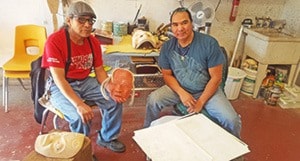Master wood carver Sanford Williams and his apprentice Agassiz native Daryl Francis met up with The Observer to discuss the latest in wood carving and First Nations issues at Williams’ studio in Hope B.C.
Williams’ work covers a plethora of First Nations and coastal legends, and is well respected in the wood carving circles and abroad. His work includes some of the most unique and beautiful masks existing in today’s market, as well as the mysterious mythological legends that accompany various totem poles, and carvings special to his culture.
Coast Salish designs are where he gets his inspiration, and the lifelong artist, who started a love affair with carving at an early age, has evolved over time.
Through tough experiences as a Residential School Survivor, Williams’ has come out with a calm and steadfastness that has heavily influenced his work and methodology; a methodology he is imparting to Francis, who has been studying under him for over a month and half now.
“He has a willingness as an artist to teach, I’ve come across a few other master carvers, and they’re so busy, so the fact that he has time to teach is an honour,” Francis told The Observer.
Design is key, and a lot of mathematics and calculations go into the conception, and correct proportional representation of an idea, as well as the proper translation from paper to wood. Sanford sketches out his designs before carving them into blocks of woods that come in various sizes.
“I’ve never done a scale drawing for a mask, and that’s what I’m learning with Sanford, also I haven’t done any design work before, so this a good opportunity for that.”
Different types of wood can be used and Williams’ enjoys finding the appropriate tree for his carvings. One of Sanford’s favourites is yellow cedar.
Of the inspired creations the wood carving duo were working on was a wolf healer mask, and they proudly shared the legend behind it.
“The Nuu Chah Nulth have had a unique connection with wolves for many millennia.Humans have provided food and comfort, while wolves have protected the territory that they share.
In this particular mask, a vulnerable wolf extends his paw as he looks to the human for help. The wolf can be seen on both sides of the main profile, and in the wolf's eye (on the left) watches the human as an instinct to protect.”
“Carvings often depict what’s going on in the culture, and an Elder Mask, is among one of the favourites,” said Francis. “We try to carve pieces that have Elders in them because they are so important in our culture.”
Francis considers himself an intermediate carver though he has had the opportunity to work with other Master carvers such as Stan Greene and George Pennier.
Predominantly working in Coast Salish style like Williams, Francis is moving towards showcasing his material in a gallery, but hasn’t had the opportunity to do so yet, and is working toward that goal, though it is not his only objective.
‘I’m looking for individuals who are willing to sit and share and talk stories,” he said of his experience with Williams.
According to Francis apprenticeship is essential to becoming a Master Carver, an art form and trade that takes years of study and practice to perfect.
Artists have traditionally been trained under other great carvers, a practice that will hopefully gain more traction, in today’s fast and modern culture.
Having the experience is also a pleasurable and cathartic feeling for the carver, who enjoys the challenge.
Francis through his uncle, started wood carving, as a way to deal with issues of alcoholism and to overcome a dark period in his life. By being tactile, imaginative and having a focus, Francis acknowledged that his life has improved immeasurably and that it has given him a purpose.
“It’s a good thing to do for my own well-being.”
